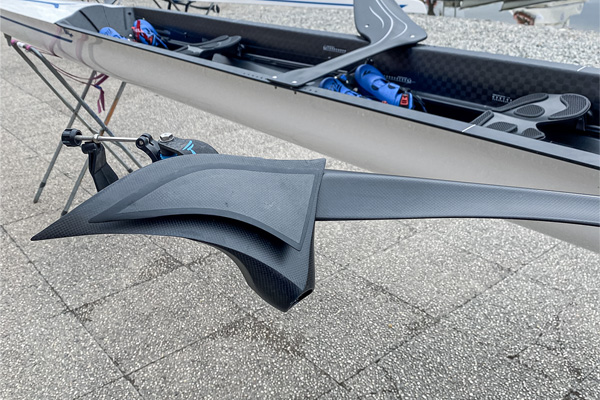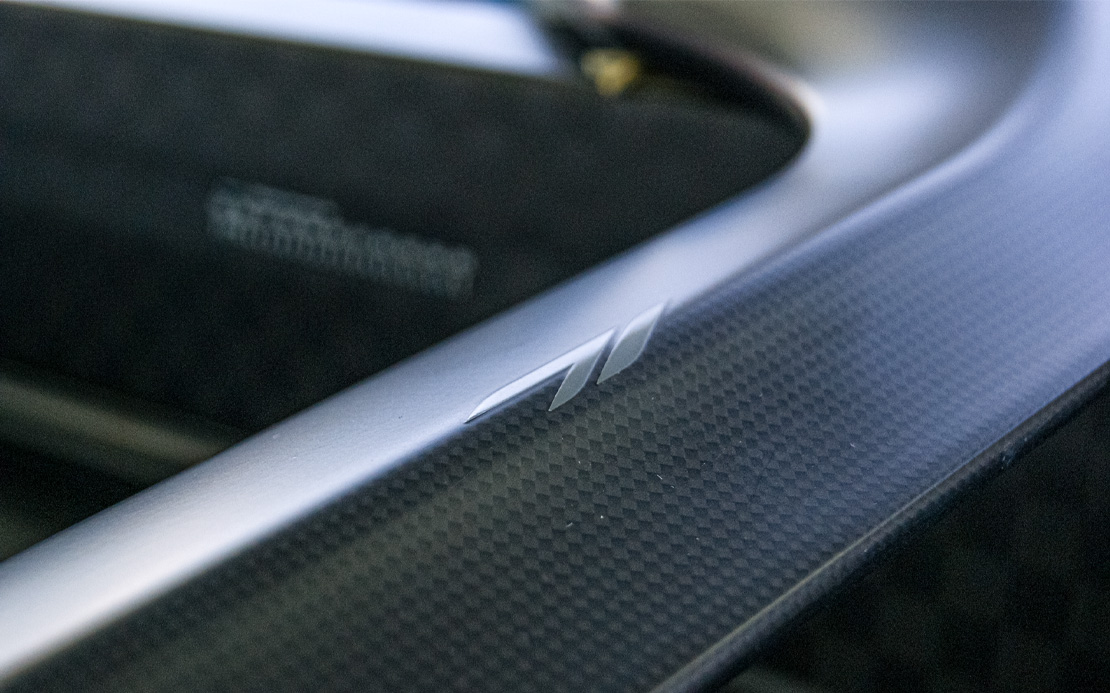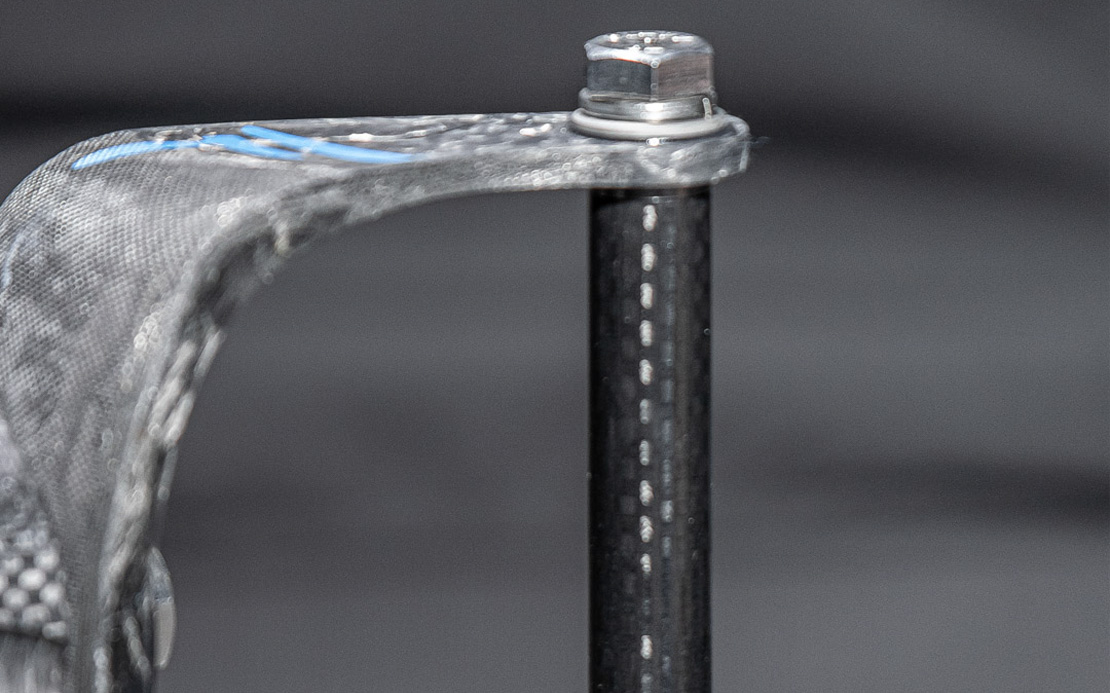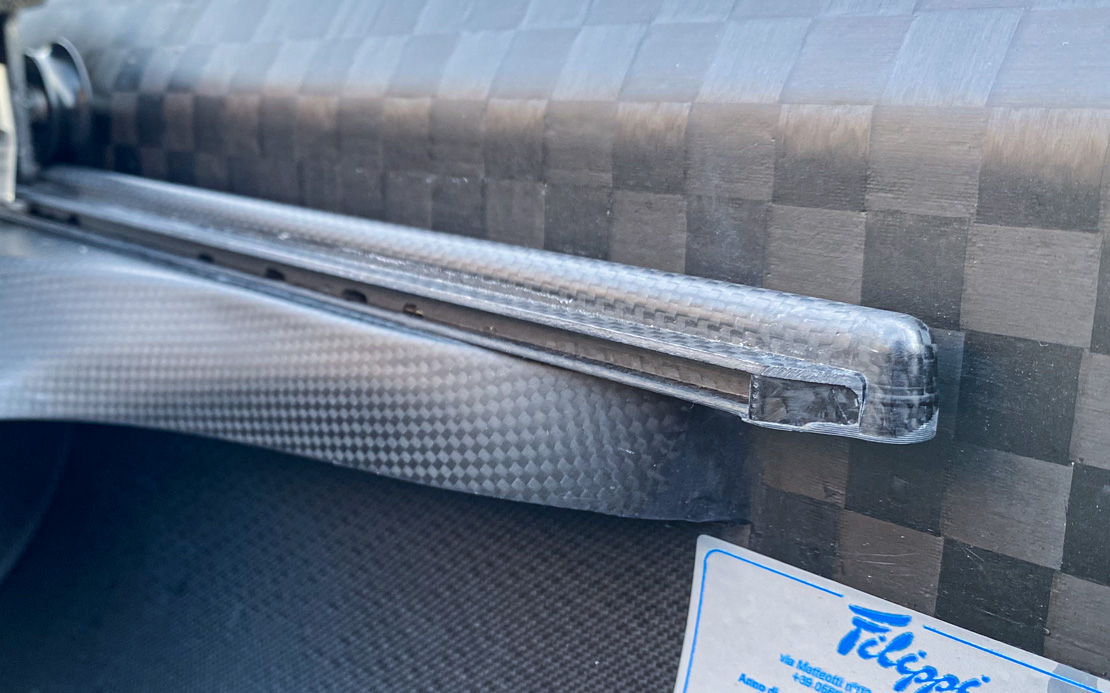Monolithic: this is the new standard for rowing boats.
Monolithic design has always been our focus because it yields a rigid product capable of harnessing the full strength of the rower. The materials available and their characteristics have always determined the design limits, which have been constantly expanded over time. The introduction of Kevlar, fiberglass, and later carbon fiber has revolutionized hull lamination. It ushered in a new concept for rowing boats, marking the end of the era of wooden hulls.
From there, we have taken numerous steps: many focused on improvements, while others were more impactful, such as the Aliante rigger. These steps led to innovations like the Koridion foot stretcher, initially developed for skiffs.
We thought we had produced just another technical upgrade, but we soon realized that the new technology had infinitely greater potential. Design limits were further expanded, giving us the freedom to rethink every component from its foundation: the geometries.
We redesigned everything. Symmetrical sections were no longer necessary. Additional hardware was eliminated. Chassis, slots, crossbars, u-bolts, axles... they could all be fused into a single piece. We embraced this new freedom because we knew it would lead us to our true goal.
We designed the monolithic boat.
The new geometries conceal a soul. In Koridion.
Koridion foam is at the heart of the change: an active core that expands uniformly with heat, with very precise accuracy. A patented material that will only be found in Filippi boats, as we have exclusive rights to its use.
Autoclave or vacuum bag techniques, previously used to produce our components, posed limits especially on resin and carbon lamination. Simply put, it was impossible for us to evenly distribute the resin, leading to areas of excess or insufficient material in each product. This resulted in excessively rigid and critical points.
With Koridion as the core, we broke this limitation: now we mold the component shape in Koridion via plastic injection molding first, then coat it with carbon fiber and resin, and finally press everything together in a mould.
The temperature increase during pressing allows Koridion to expand, creating dual pressure: external and internal. Thanks to precise temperature control and the uniform expansion capacity of the active core, we achieve uniform and consistent lamination throughout the component.
The core remains inside forever, significantly contributing to overall rigidity. Both this and the uniform lamination have allowed us to reduce the amount of carbon and resin used. Considering that Koridion has a weight of 25kg/m3, we have also reduced the overall weight.
However, the most significant feature is the ability to redesign the entire geometry. Here lies the major difference: components that were previously composed of multiple parts and materials now become a single form. Every screw or joint has been abandoned in favor of a different component that incorporates all the old parts.
The small but several energy dispersions no longer exist: now the boat no longer limits the rower's strength.
All this is the foundation of the Performance configuration change.
The new lay-up that keeps pace with innovation.
Innovation, to be truly effective, cannot only concern individual components because the rower's strength passes through the entire rowing boat. The hull, previously optimized for the old components, had to be redesigned to harness strength as much as the rigger, seat, and foot stretcher.
We had another advantage to leverage: the weight gain of the components. So we reinforced the hull lay-up with additional layers of carbon fabric, applying in fact a redistribution of the boat's weight.
The lay-up in the Performance configuration is tailored to reinforce specific points of the hull. Just as rigger, seat, and foot stretcher rigidity increases, the same happens at the base: the athlete's strength channels throughout the boat with extremely reduced energy dispersion compared to our standard configuration.
All this without any increase in the overall weight of the rowing boat.
New monolithic Aliante rigger: the flagship of the Performance configuration.
The protagonist of all this change is precisely the new Aliante rigger.

Here, we were able to use a Koridion with an extremely low density compared to other upgrades, which allowed us to create a multi-module component: whereas before the steel slot was glued to the ends of the rigger, now we have included it inside the mould, making it monolithic.
We reduced the thickness of the lay-up: in the most critical points, we went from 6mm to tenths of a millimeter, meaning we achieved a reduction of a factor of 10 compared to the past. While maintaining the same volumetric footprint, we removed approximately 40% of the weight.

The stiffness that we previously achieved only with a symmetrical section is now surpassed with a less bulky asymmetric geometry. The height and angle settings configured in the hilt now remain true during the rowing action because the deformation of the rigger is drastically reduced; consequently, the oar will behave as expected, following a horizontal path without excessive sinking during the stroke. The Koridion in particular also allows for a significant reduction in vibrations in the final part.
The new geometry is aimed at better aerodynamics both with the flow generated by the boat's advancement and in the case of crosswinds. Together with the active core, it also allows for better distribution of tensions within the component and dampens the pneumonic effect of carbon structures.
The hilt, hilt holder, washer in forged carbon and carbon pin give the final touch of stiffness and lightness, with a 30% reduction in weight compared to steel and aluminum components, to elevate the new Aliante rigger above our previous version.
The weight gain has allowed us to develop an optional extension: a pair of carbon wings placed on the rigger end, reducing the aerodynamic resistance that the hilt and oarlock produce with the airflow.
The upper wing deflects the airflow above the oarlock, while the dual-channel structure of the second wing redirects the lower airflow upwards, where it will be drawn into the vortex already created by the upper wing.

The new monolithic seat. With convex rails.
Among the revised components, the seat is the one that was made up of multiple disjointed parts.
Like the rigger and foot stretcher, everything here has been combined into a single form. The metal chassis and respective screws have disappeared, eliminating all energy dispersion caused by these junctions.

We designed a less bulky monolithic shape, innovative both on the top and bottom of the seat. Developing a unique geometry allowed us to increase overall rigidity not only through materials but also through design.
The advantages of the new applied technology ensure that the seat does not deform during the rowing action, always keeping the wheels perfectly parallel, able to slide along the rails without friction. Height adjustment has been integrated along with wheel fastening and the hook that secures the seat to the rail.
The other major innovation, visually impactful as well as performance-driven, concerns the upper pad, which now breaks down into six parts, covering just the areas of real interest for athlete comfort. Unlike the previous version, made of neoprene with uniform density, we sought a new technology that could make a difference: the additive technology.
The new pad is created in 3D latex using generative design. The most interesting aspect of this technology is the ability to create areas of varying rigidity, breaking the uniformity of the past and concentrating rigid and soft zones according to the rower's physique and movement.

Concave wheels, convex rails. Wheels made of a technopolymer, rails made of carbon fiber. The two materials in contact reduce the coefficient of friction compared to the plastic and aluminum previously used. We reversed the shapes to prevent the natural accumulation of impurities that would compromise smooth sliding. But the details are not over yet: we equipped the wheel with a bearing with an internal stainless steel pin, tested to resist corrosive agents. And the bottom part of the rail is made of carbon fiber instead of plastic.
Plastic end caps on the rail ends have been eliminated, gaining usable length for sliding. Thanks to this, we were able to develop a single rail size suitable for all boat categories.
The seat can now be easily inserted and removed from the boat thanks to slots cut into the rails, through which the hooks of the seat can pass, ensuring stability during rowing.

Rigidity, non-deformability, and perfect slide are the major advantages achieved. Even with a weight gain of approximately 350g per seat.
The monolithic foot stretcher and the new plate.
The revolution started with the skiff version of the new foot stretcher. Now we have adapted the new design to all boat categories.
Crossbars, u-bolts, wing plate, screws. Once again, everything is combined into a monolithic form. Together with the rigger, the foot stretcher is a component on which the rower's force is exerted. Again, the geometry and technology used make a big difference compared to our previous version.

The new geometry leaves the top flat with thickness on the lower part of the foot stretcher, which compensates for the plate thickness to create an even support surface. On the back, the integration of the crossbar has led to simply innovative shapes compared to the past.
Angle adjustments of 42° and 45° can be set by changing the hole in the keel attachment and using spacers in the racks attachments (or on the gunwales in the case of skiffs).
Forged carbon terminals perfectly transmit the load to the racks, made of the same material. In the case of skiffs, we reinforced the gunwale holes with carbon reinforcements.
For the new plate, entirely made of carbon fiber, we have thought of an integration that speeds up setting operations: foot rotation can be set without having to unscrew the shoes and the plate, allowing adjustment even while seated in the boat. Just loosen/tighten a simple bolt and rotate the foot to the desired angle.

In addition to reducing energy dispersion and vibrations, we gained approximately 200g per seat compared to our previous version.
Other innovations completing the Performance configuration
Rotor steering system
From the thick, heavy, and bulky steel cable, we have moved to a decidedly minimal, aesthetic, but above all more functional approach.
Whether it's a boat with a coxswain or a steering system, we have placed rotors on the steering axis with which it is possible to adjust the Dyneema cables, which have reduced thickness and weight but are perfectly resistants. By unscrewing the stern deck cap, you can adjust the rotors and have an indicator of the rudder's 0 angle. The athlete controlling the steering can in turn adjust the rigging with millimetric precision through a rotor installed on the steering plate, and there will be an indicator on the plate showing the point where the rudder is at a 0 angle. A similar adjustment has also been designed for coxswains.
A new restyling to celebrate the technological breakthrough
We have ridden such a huge technological leap that we thought it was necessary making a restyling of the graphic signs of Filippi boats. Such innovation finally deserved an image update that would make it clear at a glance that one is facing a new Filippi.

The iconic blue stripes, which have always made our brand recognizable at a glance and depict the F of Filippi, L of Lido (the founder of the shipyard), and the water division as the boat passes over the decks, have been adapted to the sleek curves and shapes of the boat.

The new design maintain a clear connection with the marks that every rower recognizes and keep the sense of speed transmitted unchanged, but now they harmonize with the boat's shape and give a modern appearance. The restyling will encompass all Filippi boats, regardless of the chosen configuration. Performance boats will be distinguished by the configuration logo on the bow.
Soon you will be able to configure the Filippi Performance online.
Sign up to be notified when you can configure it from our online configurator.






































